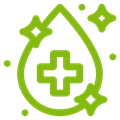
Module 3
Tackling the social determinants of health and workers' and occupational health and safety

Tool 11: Water, sanitation and hygiene
Tool overview
Safe drinking-water, sanitation and hygiene (WASH) are crucial to human health and well-being. Safe WASH is not only a prerequisite to health but contributes to livelihoods, school attendance and dignity and helps to create resilient communities living in healthy environments.
Emergencies are increasingly becoming more complex and affecting more populations than ever before. Climate change, natural disasters, growing inequities and urbanization all contribute to the record 65 million people who have been forced from their homes. WHO is coordinating a global response to events in 27 countries, with dozens more dealt with at regional level. These may be a response to a natural disaster (such as a hurricane), a conflict, a disease outbreak or mass migration; in many cases it is combination of these. WASH is an important element in both provision of health care and in the reduction of health risks during an emergency and in the future preparedness planning.
Note: GEMI: Interagency initiative focused on monitoring SDG 6; GLAAS: UN-Water Global Analysis and Assessment of Sanitation and Drinking-Water; JMP: WHO/UNICEF Joint Monitoring Programme for Water Supply, Sanitation and Hygiene.
Guidance and tools
Water, sanitation and hygiene
Guidance, training, reports
Progress on household drinking-water, sanitation and hygiene 2000-2022: Special focus on gender
The 2030 Agenda for Sustainable Development called for ‘ensuring availability and sustainable management of water and sanitation for all’ under...
WHO water, sanitation and hygiene strategy 2018-2025
This strategy sets out the direction and role of WHO within the context of the SDGs and WHO’s 13th Programme of Work. It reinforces WHO’s...
The fourth edition of the World Health Organization’s (WHO) Guidelines for drinking-water quality (GDWQ) builds on over 50 years of guidance by WHO...
